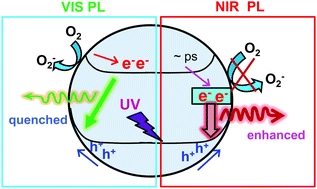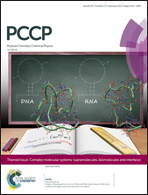Oxygen induced enhancement of NIR emission in brookite TiO2 powders: comparison with rutile and anatase TiO2 powders
Abstract
Brookite TiO2 attracts considerable attention in photocatalysis owing to its superior performance in several photocatalytic reactions. In this work, we investigated the behavior of charge carriers in brookite, rutile, and anatase TiO2 by using photoluminescence (PL) and transient absorption (TA) spectroscopies. PL measurements revealed that brookite TiO2 exhibits a visible and a NIR emission at ∼520 nm and ∼860 nm, respectively. Addition of methanol vapor quenched both the visible and NIR emissions by the hole-consuming reaction of methanol. However, exposure to O2 shows curious behaviors: the visible emission was quenched but the NIR emission was enhanced. These results can be accounted for by the enhancement of upward band bending resulting in the effective separation of electrons and holes into the bulk and the surface, respectively. Furthermore, the shallowly trapped electrons, which are responsible for visible PL, are consumed by O2; hence, the visible emission is quenched. However, in the case of NIR emission, the deeply trapped electrons are responsible and they are mainly located at the surface defects. The O2 adsorption promotes the hole accumulation at the surface and then assists the recombination of these deeply trapped electrons, resulting in the enhancement of the NIR emission. We also found that the lifetime of NIR emission (τ1 = 43 ± 0 ns and τ2 = 589 ± 1 ns) was much longer than that of visible emission (τ1 = 15 ± 0 ns and τ2 = 23 ± 0 ns), since the mobility of these deeply trapped electrons to encounter with holes is lower than that of the shallowly trapped electrons. However, even for this slow NIR emission, the actual lifetime of the deeply trapped electrons estimated by TA (1.5 ± 0.0 μs and 17 ± 0 μs) was one or two orders of magnitude longer, confirming that non-radiative recombination is dominant and it is much slower than radiative recombination: TAS and PL provide detailed information on the radiative and non-radiative recombination processes. The PL of anatase and rutile TiO2 powders was also measured and the difference from brookite TiO2 was discussed.

- This article is part of the themed collection: Complex molecular systems: supramolecules, biomolecules and interfaces


 Please wait while we load your content...
Please wait while we load your content...